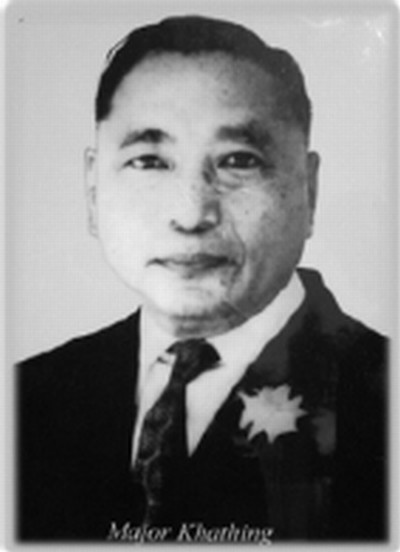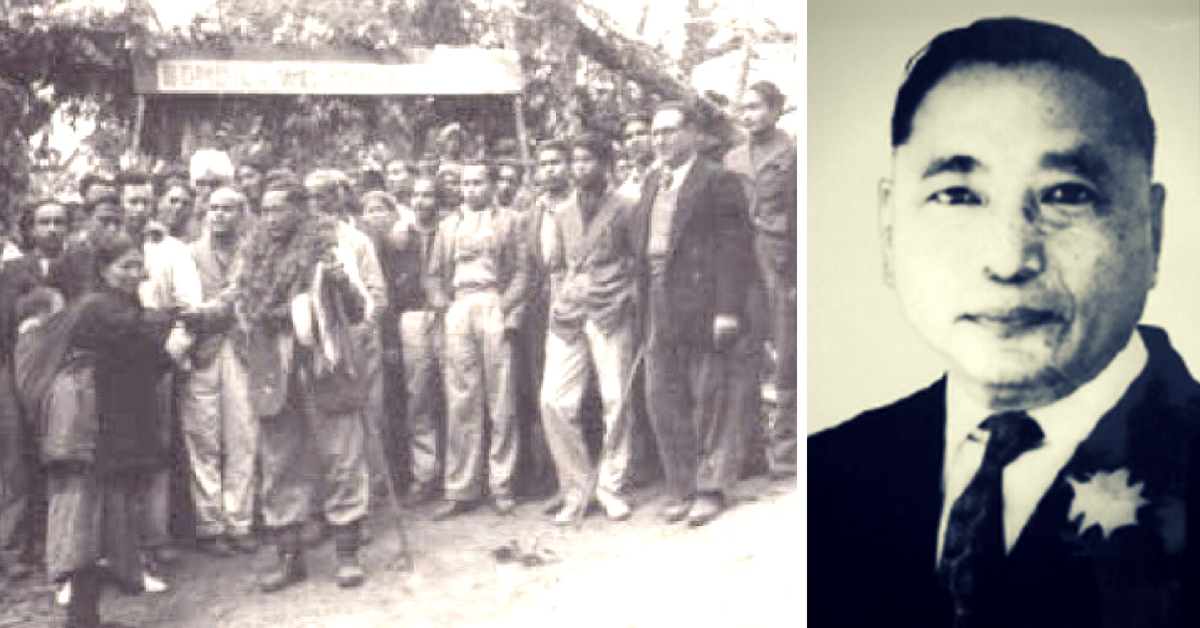In the fabled history of Independent India, many citizens from its frontier regions—Ladakh and the Northeast—have significantly contributed to the process of nation-building.
Some have received due recognition while many others remain shrouded in anonymity. One such soldier, diplomat and civil servant, is Major Ralengnao (Bob) Khathing. Even by the remarkable standards set by some of Independent India’s most illuminating figures, Major Khathing stands tall, but very few know about his contributions.
Born into the Thangkul Naga tribe on February 8, 1912, at Ukhrul in Manipur, Khathing attended a local missionary school until Class V. An exceptionally bright student; he received a state scholarship to join the Government High School in Shillong (then the capital of a united Assam).
After passing out of school, Khathing went to the Bishop Cotton College in Guwahati, where he became the first tribal from Manipur to graduate. In a remarkable career marked by many glass-ceiling shattering moments, this was the first.
Following graduation, he started a school in Barasingha in the Darrang district of Assam, before a local British civil servant convinced him to take over the Headmaster’s position back home at the Ukhrul High School.
In 1939, however, World War II began, and Khathing decided to enrol in the British Army. However, he encountered a serious problem.
“The British rules were strict: Recruits had to be five feet four inches tall, except the Gurkhas who could be recruited at five feet two inches. Bob, like many in the North-East, was too short, five feet three inches only. But with a clever hairstyle and the help of an understanding officer of the Royal Army Medical Corps, he made it. He was the first Manipuri to get a King’s Commission,” writes French historian Claude Arpi, who has long documented India’s presence in its frontier regions.
Following a stint of basic training in Agra under Major KS Thimayya, who later went on to become the Army chief of Independent India in 1957, Khathing was commissioned into the 19th Hyderabad Regiment (later 7th Kumaon Regiment) but soon shifted to the Assam Regiment in Shillong in 1942.
As a captain, he assisted the United States Army Air Forces (USAAF) efforts against Japanese forces at Jorhat as a logistics Liaison Officer, helping them fly military transport aircrafts from India to China to resupply the Chinese war effort and the units of the USAAF based in China.
Also Read: A Legendary Plane And The Iron Will That Saved Ladakh From Pakistan!
“When Japanese choked the Burma Road, the British army formed a guerrilla outfit called ‘Victor Force’ and used hill tribals as guides and informers to the British Army to counter Japanese army. Khathing was sent to command as a local Captain of the ‘V Force’ Operation in Manipur sector to operate behind enemy lines in the Burma front.
He effectively mobilised the Tangkhul youth and leaders who brilliantly united and organised an intelligence set-up, passing information of Japanese movements to the Allied Forces. As reported, he shaved his head in a ‘Mohawk style,’ in typical Tangkhul tribesmen tradition, shed his army tunic, and purportedly slew about 200 Japanese soldiers during his command in 1942-1944,” write Dr Tuisem Ngakang, Assistant Professor at the University of Delhi and Dr Pamreihor Khashimwo, a Research Associate with Centre for Air Power Studies, in a tribute published in The Sangai Express.
For his contribution to the British War effort, he was awarded the prestigious Member of the British Empire (MBE) in December 1943 and received the Military Cross in August 1944. After the war, Khathing quit the army and had a brief stint as Minister of Hills Administration for the Government of Manipur.

To the uninitiated, many princely states had taken steps towards Independence after the war. After years of British rule, Manipur began establishing a democratic form of government with the Maharaja of Manipur as its head in 1947. Unfortunately, with the threat of Burmese occupation looming large, the Maharaja felt accession to India was a better choice. After the dissolution of the Manipur Assembly, the state became a part of the Indian Union in 1949.
With the dissolution of the Manipur Assembly, Akbar Hydari, the first Governor of Assam, requested Khathing to join the Assam Rifles, where he served as an Assistant Commandant. On August 15, 1950, when the region was devastated by the Assam-Tibet earthquake, causing nearly 4800 casualties, Khathing was involved in coordinating and carrying out rescue and rehabilitation efforts.
However, it was his next job that would forever etch Khathing’s name in Independent India’s history. Deputed to the Khameng Frontier Division of the then North East Frontier Agency in modern-day Arunachal Pradesh as Assistant Political Officer (APO), Khathing’s diplomatic nous, charisma and steely determination would play a critical role in bringing Tawang into the Indian Union without firing a single bullet.
Under orders of the then Assam Governor Jairamdas Daulatram, Khathing assisted 200 soldiers of the 5 Assam Rifles and 600 porters in their march towards Tawang on January 17, 1951.
Before World War II, Tawang was under the administrative control of the then independent Tibetan government, despite British attempts to annex it. Things, however, changed in 1944 when a unit of the Assam Rifles took control over a part of the Tawang tract lying south of the Sela pass, sending Tibetan tax-collectors packing. However, Tibetans residing north of the pass remained untouched.
All this changed with the arrival of APO Khathing and his men.
“A few days after his arrival, he selected a high-ground near the Tawang Monastery for meeting the Dzongpens, the Commissioners from Tsona in Tibet and the village elders (gaon burahs). Bob walked to the place, while 100 riflemen encircled the ground,” writes Claude Arpi. While soldiers were ready to battle in the event of an impasse in talks, APO Khathing used his shrewd diplomatic skills to win over the locals.
What he soon realised was that the indigenous Monpa tribal community was struggling under the harsh taxes imposed by the Tibetan administration, and what Khathing did was sell the idea of India, its democracy and most importantly that its government would never exploit them. It worked!
This is how Khathing won over their hearts. Locals still talk about his exploits to this day.
Merely six weeks after Khathing arrived in Tawang, Indian Prime Minister Jawaharlal Nehru wrote a note to his Foreign Secretary on March 18.
Also Read: Buddha Purnima: Here’s Why PM Nehru Took Buddha’s Relics To Ladakh in 1950!
“I constantly hear about the activities of the North and North-East Border Defence Committee. These activities have resulted in action being taken on the Tibetan border and in Nepal. At no stage have these matters been brought up before me for consultation, although apparently, consultations have taken place with the Governor of Assam and other people far away. I am greatly concerned about this matter because, as I have already mentioned to you, the manner of our going to Tawang and taking possession of it and thus creating some international complications has not been a happy one. I am yet not quite clear how all this was done without any reference to me,” Nehru wrote.
However, Arpi recounts that days before his untimely death, Sardar Patel, who was Home Minister, had issued an order to Jairamdas Daulatram and APO Khathing to conduct this operation without apparently taking Nehru into confidence. Patel did not want a repeat of the Kashmir situation. Nehru’s unhappiness, however, did not have any real consequences for Khathing’s career.
Also Read: The Extraordinary Ladakhi Monk Who Helped Bring Peaceful Democracy to Mongolia
Following stints across various administrative positions in the Northeast as a member of the Indian Frontier Administrative Service (a civil service unit operating in Northeast tribal frontier regions, which was soon merged with the IAS), his next major assignment came when the Indo-China War broke out in 1961-62. He was appointed the Security Commissioner of NEFA and Chief Civil Liaison Officer with the Army IV Corps stationed in Tezpur.
By some accounts, he even played a significant role in the establishment of the Sashastra Seema Bal (SSB) after the war.
However, his final crowning moment occurred when he was appointed the Ambassador of India to Burma in 1972. Thus, Khathing became the first person from a tribal background to become the Ambassador of India.
“It is said that he helped to bring the ‘Bamboo Curtain’ down on the Military Junta in Myanmar. Also, he successfully tackled the 800 km long Indo-Myanmar border issue discreetly, fairly and amicably with Burma. Khathing retired from active service in 1975,” writes Dr Tuisem Ngakang.
Khathing passed away on January 12, 1990. Although he was honoured with the Padma Shri in 1957 and ‘Khathing Point,’ a place in Bomdila, Arunachal Pradesh, is named after him, this son of India has not received the recognition he deserves. It is high time we change that.
Like this story? Or have something to share? Write to us: contact@thebetterindia.com, or connect with us on Facebook and Twitter.
NEW: Click here to get positive news on WhatsApp!
If you found our stories insightful, informative, or even just enjoyable, we invite you to consider making a voluntary payment to support the work we do at The Better India. Your contribution helps us continue producing quality content that educates, inspires, and drives positive change.
Choose one of the payment options below for your contribution-
By paying for the stories you value, you directly contribute to sustaining our efforts focused on making a difference in the world. Together, let's ensure that impactful stories continue to be told and shared, enriching lives and communities alike.
Thank you for your support. Here are some frequently asked questions you might find helpful to know why you are contributing?

